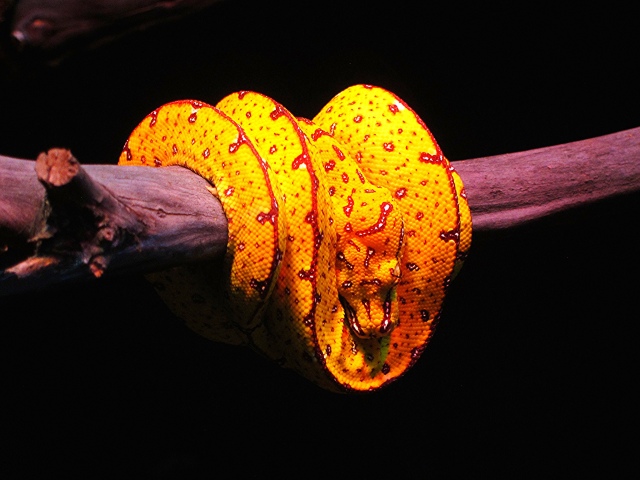TAXONOMY
Kingdom: Animalia
Phylum: Chordata
Class: Reptilia
Order: Squamata
Family: Boida (Boas)
Genus/species: Eunectes murinus
GENERAL CHARACTERISTICS: Gigantic, heavy-bodied, dark green boa with dark spots. A distinctive stripe runs from the rear edge of the eye, diagonally downwards to the back of the head. The stripe is edged with black and varies in coloration, from greenish to orange. Eyes and nasal openings are on top of their heads, allowing them to lay in wait for prey while remaining nearly completely submerged. The female dwarfs the male and is almost five times heavier.
Like all snakes, anaconda have a forked tongue they helps them locate prey and mates and to navigate their environment, in conjunction with the tubular Jacobson’s organ in the roof of the snake’s mouth.
SIZE: Up to more than 29 feet (8.8 meters), weigh more than 227 kilograms (550 pounds) and measure more than 30 cm (12 in) (30 centimeters) in diameter.

DISTRIBUTION/HABITAT South America: Amazon and Orinoco drainages from Colombia and Venezuela to East Bolivia and Central Brazil. Associated strongly with watercourses, swamps and other freshwater locations.
DIET IN THE WILD: They feed on any prey that they can kill and swallow including monkeys, deer, peccaries, pacus, agoutis, birds, fish, caiman and turtles. Prey usually killed by constriction; prey suffocates and often drowning in water. Usually feed in water. Jaws attached by stretchy ligaments allow them to swallow their prey whole, no matter the size, and they can go weeks or months without food after a big meal. Primarily a lie-in-wait predator.
Academy Diet: Frozen/thawed rabbits (P. Dwight Biologist).
REPRODUCTION: Green anacondas are ovoviviparous (eggs hatch in the mother and snakes are born alive). They are polyandrous breeding with multiple-male aggregations of up to 13 males. Female anacondas retain their eggs and give birth to two to three dozen live young. Baby snakes are about 0.6 meters (2 ft). After mating, the female may eat one or more of her mating partners, as she does not take in food for up to seven months after birth.
PREDATORS:Caimen. Jaguars, and green anacondas.
MORTALITY/LONGEVITY: Lives to over 29 years.
REMARKS: The anaconda is, pound for pound, the largest snake in the world. The reticulated python, can reach slightly greater lengths, but the enormous girth of the anaconda makes it almost twice as heavy. Can remained submerged for a very long time lying in wait for its next meal.
Some indigenous peoples of Brazil and Peru use green anacondas body parts for magical and spiritual properties, in ritualistic purposes.
Green anacondas are among the only snakes that can reach the proportions necessary to possibly kill and consume a human being. However, attacks by green anacondas are rare due to low.
The California Academy of Sciences specimen is a female. Length/wt 2013: 13 ft 11 inches long and weight 92 lbs.
2008 she was 3m (10 feet) long and weighed 90 lbs.
Color of Life Note: The dark brownish-green Anaconda demonstrates concealment by laying hidden in the murky waters of the Amazon. It is more visible at the California Academy of Sciences exhibit water which is markedly more transparent.
References
California Academy of Sciences Steinhart Aquarium Flooded Amazon Anaconda Exhibit 2018
U. of Michigan Animal diversity Web https://animaldiversity.org/accounts/Eunectes_murinus/#D1CC06F0-924A-11E1-9D4D-002500F14F28
Encyclopedia of Life eol.org/pages/794661/overview
Ron’sWordpress shortlink http://wp.me/p1DZ4b-bt
Ron’s flickr http://www.flickr.com/photos/cas_docents/sets/72157608449603666/with/3636385495/






















